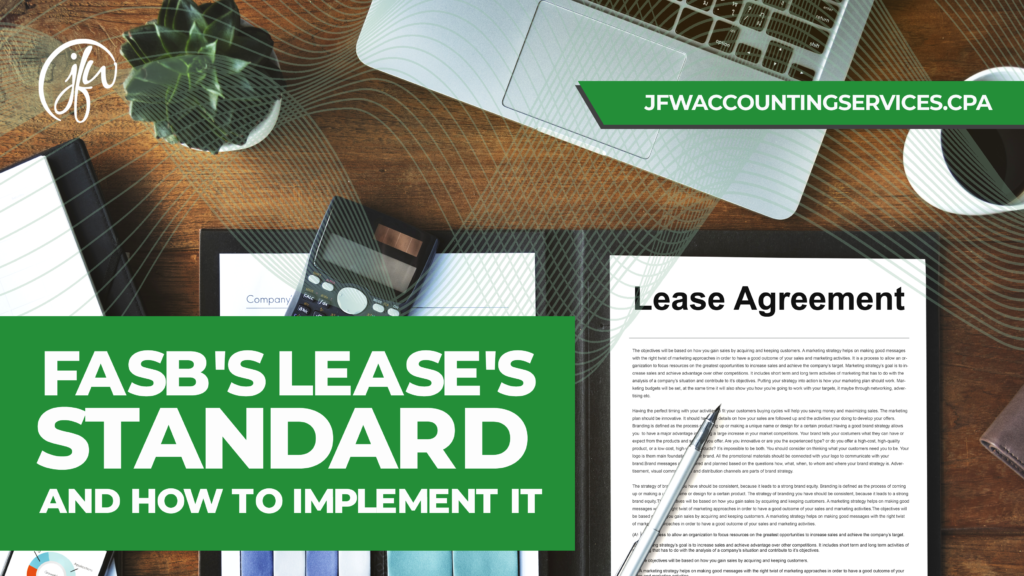Introduction
The FASB issued Accounting Standards Update (ASU) No. 2016-02, Topic 842, on February 25, 2016. The update on FASB Lease Standard came after many years of consideration. The purpose of this ASU is to increase the transparency of financial reports and requires that leases be recognized on an entity’s balance sheet. The FASB considers a lease as a representation of valid assets and obligations because the lessee receives potential economic benefits by using the asset.
All leases and subleases of property, plant, and equipment, of twelve or more months, are required to be represented on Balance Sheets. ASU No. 2016-02, Topic 842 does not apply to leases of intangible assets, biological assets, assets under construction, inventory, or exploratory permissions, like those granted for minerals, oils, and gas.
Amendments
Since the ASU No. 2016-02, Topic 842, was issued, the following amendments were issued to the update:
- ASU No. 2018-01, Leases (Topic 842): Land Easement Practical Expedient for Transition to Topic 842
- ASU No. 2018-10, Codification Improvements to Topic 842, Leases
- ASU No. 2018-11, Leases (Topic 842): Targeted Improvements
- ASU No. 2018-20, Leases (Topic 842): Narrow-Scope Improvements for Lessors
- ASU No. 2019-01, Leases (Topic 842): Codification Improvements
- ASU No. 2019-10, Financial Instruments—Credit Losses (Topic 326), Derivatives and Hedging (Topic 815), and Leases (Topic 842): Effective Dates
- ASU No. 2020-05, Revenue from Contracts with Customers (Topic 606) and Leases (Topic 842) Effective Dates for Certain Entities
- ASU No. 2021-05, Leases (Topic 842): Lessors – Certain Leases with Variable Lease Payments
Effective Dates
ASU 2016-02 stated that the update would go into effect with fiscal years beginning after December 15, 2018, and including interim periods, for public entities, and nonprofits what issues traded securities, and employee benefit plans that file with the SEC. The update was issued to go into effect for the fiscal years beginning after December 15, 2019 for all other entities. ASU 2016-02 permitted early adoption for all entities.
Some of the effective dates of ASU No. 2016-02 were updated in June of 2020 by ASU No. 2020-05, Topic 842. The amended dates most impacted certain nonprofit entities that had not issued their financial statements as of June 3, 2020. ASU No. 2020-05 deferred the effective dates. Nonprofit organizations are required to comply with the ASU No. 2016-02, Topic 842, guidelines for fiscal years beginning after December 15, 2021.
Lease Definitions
FASB ASU 2016-02 pertains to two types of leases: finance leases and operating leases.
Finance Leases
- The FASB defines leases as finance leases when one or more of the following criteria applies:
- The lessee is reasonably certain to exercise an option to purchase the asset.
- The lessee will be transferred ownership by the end of the term.
- The term of the lease is for most of the remaining economic life of the asset.
- The lease payments’ present value is far greater than the fair value of the asset
- The asset is of a specialized nature that is not expected to have an alternative use to the lessor at the end of the term.
Operating Leases
The FASB defines operating leases as all other leases where one or more of the criteria above are not met.
Compliance for Nonprofit Organizations
The FASB updated lease standard requires that entities capitalize all leases and the lease liabilities. Lessees are now required to calculate the lease liability as to the present value of the lease payments that have yet to be made during the initial period of the lease term. For subsequent terms, the liability of the lease payments is reduced, and the principal portion can be expensed.
Nonprofit organizations are impacted by ASU No. 2016-02 directly and indirectly through their business arrangements and affiliations with other companies. Nonprofits need to identify embedded leases and compare current business arrangements with the new lease specifications given in Topic 842. Long-term diligence within the accounting departments and operations will be required to ensure that the recording of leases remains compliant with the FASB.
Topic 842 Best Practices
Compliance with the new lease standards will require nonprofits and other businesses to implement changes in multiple phases. Fast track implementation processes will influence daily accounting tasks, while slow track implementation workflows will be integrated into procedures over time.
Compliance may require the following tasks:
- Identify current lease holdings
- Examine technology capabilities and identify improvement needs
- Document an implementation plan
- Communicate the new standards and implementation plans with the organization’s staff
Bottom Line
FASB issues updates, like the ASU No. 2016-02, address current deficiencies in financial processes or reporting. The Topic 842 update is intended to make financial statements more transparent, user-friendly, and comparable to similarly structured organizations.
Companies can minimize the stress the update puts on team members by implementing fast track and slow track workflows. Consulting with a financial advisor or accounting service can help nonprofit organizations and for-profit businesses understand how the update affects their company and create a successful implementation plan.

Jo-Anne Williams Barnes, is a Certified Public Accountant (CPA) and Chartered Global Management Accountant (CGMA) holding a Master’s of Science in Accounting (MSA) and a Master’s in Business Administration (MBA). Additionally, she holds a Bachelor of Science (BS) in Accounting from the University of Baltimore and is a seasoned accounting professional with several years of experience in the field of managing financial records for non-profits, small, medium, and large businesses. Jo-Anne is a certified Sage Intacct Accounting and Implementation Specialist, a certified QuickBooks ProAdvisor, an AICPA Not-for-Profit Certificate II holder, and Standard for Excellence Licensed Consultant. Additionally, Jo-Anne is a member of American Institute of Certified Public Accountant (AICPA), Maryland Association of Certified Public Accountants (MACPA), and Greater Washington Society of Certified Public Accountants (GWSCPA) where she continues to keep abreast on the latest industry trends and changes.

